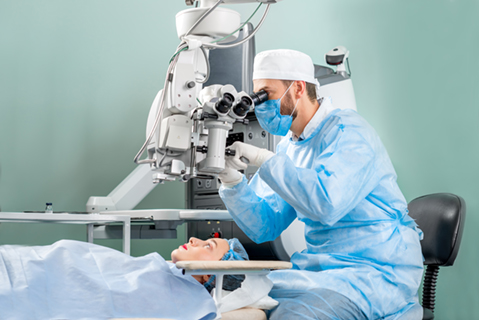Glossary

Glossary of Eye Terms
Amblyopia – A general term that denotes poor vision in an otherwise healthy eye, which cannot be corrected by eyeglasses or contact lenses. This condition is often referred to as “lazy eye”.
Amblyopia (organic) – Visual loss due to disease in the retina, or in the visual pathway between the retina and the brain.
Amblyopia (toxic) – Loss of visual acuity from excessive toxic substances such as tobacco, alcohol, or drugs.
Astigmatism – Distorted vision typically caused by an irregular shaped cornea. When the cornea is not perfectly spherical in shape, two different points of focus may be formed in the same eye, creating distorted and blurred vision. Astigmatism often accompanies myopia (nearsightedness) or hyperopia (farsightedness). Astigmatism can be corrected with eyeglasses or contact lenses.
Cataract – A condition of the crystalline lens, in which the normally clear lens becomes clouded or yellowed, resulting in blurred or foggy vision. Cataracts may be caused by aging, eye injuries, disease, heredity or birth defects.
Farsightedness – see Hyperopia
Glaucoma – Increased pressure in the eye, caused by abnormally high production of fluid or a decrease in the eye’s ability to drain that fluid. Untreated, permanent damage to the optic nerve and possible blindness if untreated. Chronic glaucoma occurs gradually, is painless, and has few warning symptoms. Acute glaucoma is marked by sudden, severe pain in and around the eye, sharply decreased vision, nausea, and vomiting.
Hyperopia (farsightedness) – Condition in which the eye focuses light rays behind, rather than on, the retina, resulting in difficulty in seeing near objects clearly, while distant objects appear in focus.
Macular Degeneration – Damage or breakdown of the macula, the central point of focus on the retina. It is usually caused by aging as the tissues in the eye thin and begins to break down. Symptoms include loss of color vision, a dark or empty area in the center of the visual field, or blurred vision in that area.
Myopia (nearsightedness) – Condition in which the eye focuses light rays in front of, rather than on the retina, resulting in near objects being seen clearly and distant objects being blurred.
Nearsightedness – see Myopia
Ophthalmologist – A medical doctor (M.D. or O.D.) who specializes in treating diseases of the eye and eye surgery.
Optician – One who fits, fabricates, and dispenses eyeglasses. An optician fills prescriptions for eyeglasses and other optical aids as specified by either optometrists or Ophthalmologist.
Optometrist – A board certified doctor of optometry (O.D.), licensed to examine eye disease and other abnormalities of the eye, to administer certain medications, and to prescribe and dispense eyeglasses and contact lenses as well as other optical aids.
Presbyopia – Loss of the eye’s ability for “accommodation” (focusing on near objects) with age. Occurring in one’s early forties, we often have to hold menus and books at arm’s length in order to read. Presbyopia can be treated with eyeglasses.
Strabismus – Misalignment of the two eyes, in which they point at different positions. Strabismus is more common in children and eyeglasses, vision training, and/or surgery can correct it.

